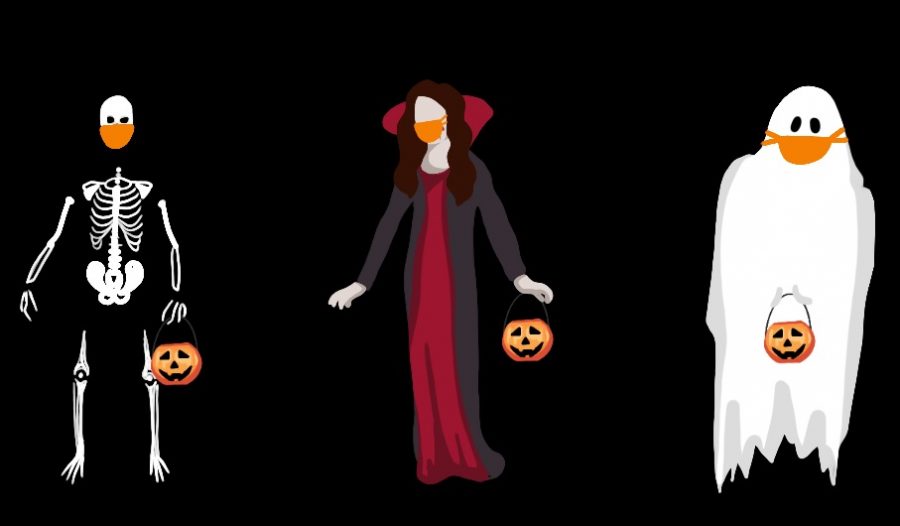CDC guides people towards safer Halloweens
Oct 19, 2020
As the end of October nears, students in Champaign-Urbana will be looking for ways to celebrate the Halloween season. While this time of the year normally sees campus filled with clever DIY costumes, cobwebs decorating busy house parties and friends visiting from out of town to partake in the festivities, the pandemic has put a halt to many of these traditions.
The campus has implemented vigorous tactics to try and keep students and faculty safe, many guided by the recommendations of the Centers for Disease Control and Prevention. The campus has seen some degree of success with these precautions in limiting the spread of the virus; however, as the holiday approaches and students look for ways to celebrate, they may engage in riskier behaviors.
The CDC’s page titled “Holiday Celebrations” says several factors may increase threats to the health and safety of a community during Halloween as well as other autumn and winter holidays. Some of these factors include location, travel, duration, numbers and behavior.
Indoor gathering spaces pose greater risks to attendees than outdoor gatherings because of the lack of air ventilation. Inviting guests from out of town can also be dangerous. They may either be coming from areas with higher levels of COVID-19, introducing greater risk to this community, or they may come from lower-risk areas and their return home would spread it further.
Short-term events and gatherings with small numbers are preferable to longer-term events with more people than can be responsibly socially distanced. The CDC offers no specific number for attendee limit recommendations; instead, it depends on the capacity and capability of the venue to socially distance guests.
Get The Daily Illini in your inbox!
Behavior is one of the primary factors in how safe an event or gathering may be for those who attend. In order to ensure the event is as safe as possible, guests must follow the procedures that have been recommended since March: Social distance from others, wear a mask covering both the nose and mouth and frequently wash hands.
The CDC page sorted Halloween events and activities into three categories of risk: lower-risk activities, moderate-risk activities and higher-risk activities.
They advise people to avoid traditional trick-or-treating, attending overly crowded costume parties, indoor haunted houses and gatherings with people outside of one’s own house. They also caution against using alcohol or drugs, as it can cloud decisions and increase risky behavior.
For activities the organization categorized as moderately risky, it said people could have outdoor costume parties where attendants wear masks and stay six feet apart. It clarifies masks must be the standard cloth masks people use from day to day and cannot be replaced by costume masks. They also warn not to wear a costume mask on top of a protective mask, as it can further inhibit breathing.
Attending pumpkin patches, apple orchards or open-air haunted forests can be safe alternatives to crowded parties. This is, of course, if one manages to stay distanced from other groups. If technologically possible, groups can host outdoor Halloween movie nights with people spaced apart.
Champaign-Urbana will be hosting several events during the next two weeks to provide festive alternatives to traditional Halloween parties and celebrations for community members.
Throughout the month, the cities have sponsored a pumpkin hunt and a scarecrow hunt, providing clues for people to find the pumpkins and scarecrows hidden around town. They also have a virtual costume contest for participants to submit pictures of themselves dressed up in their best costumes.
A little further away in Farmer City, the town’s Main Street will be decorated as a haunted forest. In Gibson City, the Harvest Moon Drive-In Theatre will host a “Wicked Weekend” showing scary movies.
The Courtyard Café will have a similar event with a movie night on Halloween showing “The Nightmare Before Christmas.”
For those looking to stay as safe as possible, the CDC lists several activities as low-risk, safe alternatives to celebrate the season.
Students can stay in their dorms or apartments and carve pumpkins or fill their rooms with DIY Halloween decorations. Roommates can have Halloween movie nights together. Those more ambitious Halloween fanatics can coordinate a scavenger hunt around their room, apartment or neighborhood looking for themed treasures and treats.
All of these options would allow participants to fully embrace the spooky Halloween spirit without endangering those around them or themselves.






